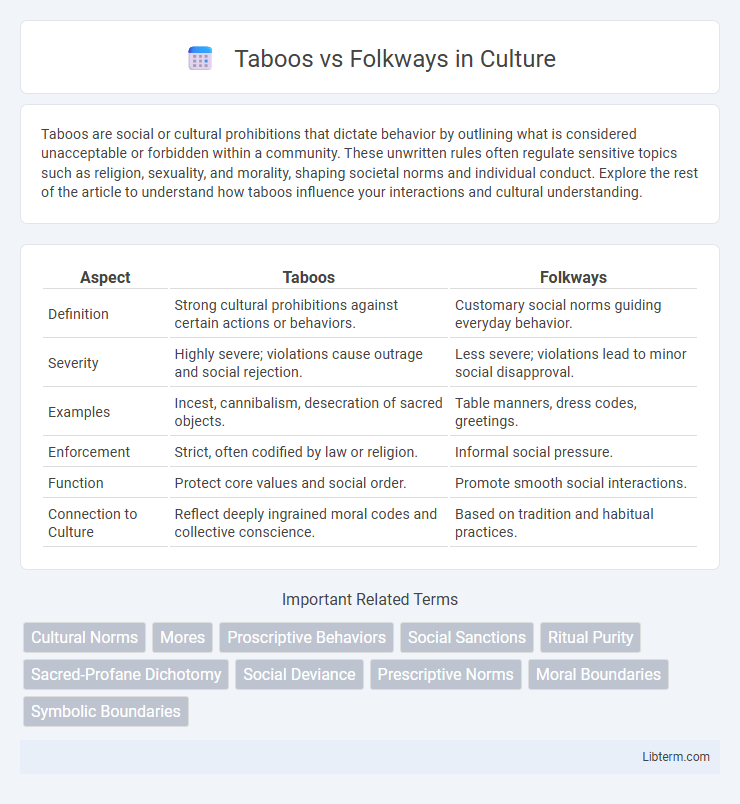Taboos are social or cultural prohibitions that dictate behavior by outlining what is considered unacceptable or forbidden within a community. These unwritten rules often regulate sensitive topics such as religion, sexuality, and morality, shaping societal norms and individual conduct. Explore the rest of the article to understand how taboos influence your interactions and cultural understanding.
Table of Comparison
| Aspect | Taboos | Folkways |
|---|---|---|
| Definition | Strong cultural prohibitions against certain actions or behaviors. | Customary social norms guiding everyday behavior. |
| Severity | Highly severe; violations cause outrage and social rejection. | Less severe; violations lead to minor social disapproval. |
| Examples | Incest, cannibalism, desecration of sacred objects. | Table manners, dress codes, greetings. |
| Enforcement | Strict, often codified by law or religion. | Informal social pressure. |
| Function | Protect core values and social order. | Promote smooth social interactions. |
| Connection to Culture | Reflect deeply ingrained moral codes and collective conscience. | Based on tradition and habitual practices. |
Understanding Taboos and Folkways
Taboos are powerful social prohibitions that forbid behaviors considered deeply offensive or morally unacceptable within a culture, often invoking strong emotional reactions and sanctions. Folkways represent customary behaviors and social norms that guide everyday interactions but carry less severe consequences when violated, focusing more on etiquette and tradition. Understanding the distinction between taboos and folkways is essential for grasping how societies regulate behavior and maintain social order through varying degrees of social pressure.
Defining Taboos: Societal Boundaries
Taboos represent the strongest societal boundaries, prohibiting behaviors considered deeply offensive or unthinkable, such as incest or cannibalism. These prohibitions are enforced through severe social sanctions, reflecting core cultural values that protect group cohesion and moral order. Unlike folkways, which guide everyday customs and etiquette, taboos mark absolute limits that threaten social stability if violated.
Folkways: Everyday Social Norms
Folkways represent everyday social norms that guide casual, routine interactions within a community, such as dress codes, greetings, and table manners. These unwritten rules help maintain social order by promoting predictable behavior without the harsh consequences associated with breaking taboos. Understanding folkways is essential for navigating cultural expectations and fostering social cohesion in diverse societies.
Cultural Contexts of Taboos
Taboos are culturally ingrained prohibitions deeply rooted in societal values and often linked to morality, religion, or identity, distinguishing them from folkways which are informal norms governing everyday behavior. In many cultures, taboos serve to maintain social order by defining unacceptable actions that provoke strong emotional responses, such as incest or cannibalism. Understanding these taboos within their cultural context reveals how they reinforce group cohesion and protect cultural heritage through enforced boundaries.
How Folkways Shape Daily Life
Folkways influence daily behavior by establishing informal norms that guide routine social interactions, such as dress codes, greetings, and table manners. These unwritten rules contribute to social cohesion by promoting harmony and predictability within communities. Unlike taboos, folkways carry less severe consequences when violated, shaping everyday life through subtle social reinforcement rather than formal sanctions.
Consequences of Violating Taboos
Violating taboos often results in severe social sanctions such as ostracism, legal penalties, or intense moral condemnation, reflecting society's deep-seated values. These infractions disrupt social order and evoke strong emotional reactions, unlike breaches of folkways, which typically lead to minor social disapproval or subtle corrective behavior. The intensity of consequences underscores the critical role of taboos in maintaining cultural cohesion and protecting fundamental ethical norms.
Reactions to Breaking Folkways
Breaking folkways typically results in mild social disapproval such as teasing, ridicule, or subtle exclusion, reflecting their role in everyday social etiquette rather than moral imperatives. These informal reactions contrast with the severe sanctions or ostracism often associated with violating taboos, which threaten deeply held societal values. Folkway violations rarely provoke legal consequences but can significantly impair an individual's social interactions within a community.
Taboos and Folkways Across Cultures
Taboos and folkways vary significantly across cultures, reflecting deeply ingrained societal values and norms. Taboos represent strict prohibitions that often carry severe social or legal penalties, such as dietary restrictions in certain religions or prohibitions against incest universally. Folkways involve everyday customs and social practices, like greetings or dress codes, which differ widely between cultures but generally have milder sanctions when breached.
The Role of Taboos in Social Order
Taboos play a crucial role in maintaining social order by establishing non-negotiable norms that protect fundamental cultural values and ensure group cohesion. Violations of taboos often provoke strong social sanctions, reinforcing collective identity and discouraging behaviors that threaten societal stability. Unlike folkways, which guide everyday behavior and social etiquette, taboos function as powerful moral boundaries critical for safeguarding communal ethics and preventing social discord.
Evolving Folkways and Shifting Taboos
Evolving folkways reflect gradual changes in social behaviors, influenced by shifting cultural norms and generational attitudes, resulting in more flexible informal customs. Shifting taboos, while traditionally rigid prohibitions, demonstrate transformation as societies reconsider moral boundaries in areas such as sexuality, technology, and social justice. Both phenomena illustrate the dynamic nature of social norms, highlighting how collective values adapt over time to new cultural contexts and ethical understandings.
Taboos Infographic

 libterm.com
libterm.com